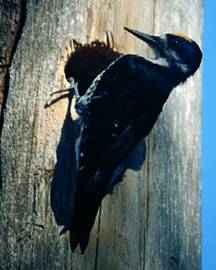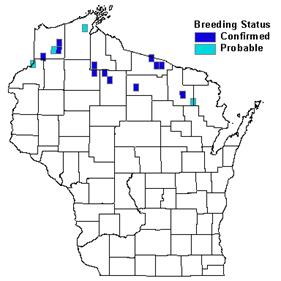Photo by Thomas Schultz


Status/Protection
- Global Rank: G5 Key to global and state ranks
- State Rank: S2B
- WBCI Priority: SGCN, State Special Concern
Population Information
Federal BBS information can be obtained at http://www.mbr-pwrc.usgs.gov/bbs/bbs.html by clicking on Trend Estimates and selecting the species in question. All estimates are for 1966-2005.
- Federal Breeding Bird Survey: non-significant increase
- Federal Breeding Bird Survey (WI): N/A
- Federal Breeding Bird Survey (BCR 23): N/A
- Federal Breeding Bird Survey (BCR 12): non-significant decline
- WSO Checklist Project: N/A (not numerous enough to be measured by the Checklist Project)
Life History
- Breeding Range: Alaska east across Canada to the Atlantic Coast southward into New England and a few northern states (Dixon and Saab 2000).
- Breeding Habitat: Swamp Conifer-Balsam Fir, Fir-Spruce, Open Bog-Muskeg, Pine Barrens, Northern Hardwood, Jack Pine, Red Pine, and White Pine.
- Nest: Cavity in deciduous or coniferous tree (Dixon and Saab 2000).
- Nesting Dates: Eggs: early May to late June (Robbins 1991).
- Foraging: Bark glean (Ehrlich et al. 1988).
- Migrant Status: Permanent resident.
- Habitat use during Migration: Extremely rare migrant; species is an uncommon permanent resident within Wisconsin range (Robbins 1991).
- Arrival Dates: N/A; Year-round resident.
- Departure Dates: N/A; Year-round resident.
- Winter Range: During rare winter irruptions, uses other forest types (conifer plantations and mixed deciduous) (Dixon and Saab 2000).
- Winter Habitat: Same as breeding habitat.
Habitat Selection
The Black-backed Woodpecker occurs in black spruce-tamarack bogs, flooded (beaver activity) lowland conifers, and burned jack pine stands. It nests in cavities found in live or dead aspen, birch, tamarack, pine, balsam fir, red maple, or spruce. Black-backed Woodpeckers often excavate cavities in the sapwood portion of tree (Dixon and Saab 2000). Nest trees average 40 cm DBH (diameter at breast height) and approx. 22-32 meters tall in the western U.S., with cavities 8-10 meters above ground. In Wisconsin the average nest trees are smaller; hence nest cavities are likely lower. Nest sites often are in areas with high tree density and in snags that are the least decayed (Saab and Dudley 1998). Bark is often removed from the snag near the entrance hole (Dixon and Saab 2000).
Habitat Availability
The coniferous lowland forests used by Black-backed Woodpeckers were widespread and relatively common historically, although they did not typically occur in large patches in Wisconsin. These forest types remain relatively common in much of their Wisconsin range today (WDNR 2005). However, beaver control programs in northern Wisconsin and fire suppression may reduce the habitat suitability in some areas. Within the Great Lakes region, coniferous lowland forests may have declined by as much as 15% and jack pine forests by as much as 79% (Snetsinger and Ventura n.d.).
Population Concerns
Due to the rarity of the Black-backed Woodpecker in Wisconsin, it is not sufficiently known whether the population is stable. This species is rarely recorded on either the Wisconsin routes of the Breeding Bird Survey or the Wisconsin Checklist Project (Temple et al. 1997, Sauer et al. 2005). Furthermore, the Wisconsin Breeding Bird Atlas effort documented few nests. Over the six-year period (1995-2000), Atlas observers found 13 nests in Ashland, Douglas, Forest, Oneida, Price, Sawyer, and Vilas counties with possible nesting in Burnett and Shawano counties (Johnson 2006). Prior to the Atlas work, positive nesting records were reported from Douglas, Price, Iron, and Waupaca counties (Robbins 1991). Intensive, targeted survey efforts would be necessary to obtain more precise population data.
Wherever this species is found, it is likely that the suppression of fires and post-fire “salvage logging” have negative effects on its population (Dixon and Saab 2000, Wisdom et al. 2000).
Recommended Management
Management in Wisconsin should focus on the maintenance of natural patterns of forest fire, wood-boring insects, disease, and decay. Management recommendations include (1) retain all trees with nest cavities; (2) retain snags in harvested areas; (3) retain the relatively older trees and a mix of healthy and diseased trees for nesting; (4) for foraging, retain dead patches of trees in a variety of decay stages, especially insect host trees, and those susceptible to future insect occupancy; (5) retain some tall hard dead trees for woodpecker drumming; and (6) limit insecticide use in forest habitats (WDNR 2005). Conservation and management strategies for this species should be focused in the following Wisconsin ecological landscapes: Central Sand Plains, Forest Transition, North Central Forest, Northern Highland, Northwest Lowlands, Northwest Sands, and Superior Coastal Plain (WDNR 2005). Within these landscapes, the best public lands to manage for Black-backed Woodpecker include Chequamegon-Nicolet National Forest and Vilas County Forest.
Research Needs
Standard census and survey efforts do not provide sufficient data for the Black-backed Woodpecker. More demographic studies are needed to better understand nest success, survivorship, and movement patterns in burned and unburned forests (Dixon and Saab 2000). Landscape relationships, including area sensitivity, juxtaposition of habitats, and use of corridors are virtually unknown and need research (WDNR 2005). This species’ rarity in Wisconsin makes these types of investigations difficult, but continued research on boreal forest bird communities in general is needed to reveal more aspects of this and other species’ ecology and response to forest management in Wisconsin.
Information Sources
- Chequamegon National Forest Bird Survey (NRRI) species account: http://www.nrri.umn.edu/mnbirds/accounts/BBWOa2.htm
- Nicolet Northern Forest Bird survey map http://www.uwgb.edu/birds/nnf/species/BBWO.htm
- North American Breeding Bird Survey: http://www.npwrc.usgs.gov
- Temple S.A., J.R. Cary, and R. Rolley. 1997. Wisconsin Birds: A Seasonal and Geographical Guide. Wisconsin Society of Ornithology and Wisconsin Department of Natural Resources, Madison, WI.
- Wisconsin Breeding Bird Atlas: http://www.uwgb.edu/birds/wbba/
References
- Dixon, R.D. and V.A. Saab. 2000. Black-backed Woodpecker (Picoides arcticus). In The Birds of North America, No. 509, (A. Poole and F. Gill, eds.). The Birds of North America, Inc. Philadelphia, PA.
- Ehrlich, P.R., D.S. Dobkin, and D. Wheye. 1988. The birders handbook: a field guide to the natural history of North American birds. Simon & Schuster, Inc. New York.
- Johnson, R. 2006. Black-backed Woodpecker. In The Wisconsin Breeding Bird Atlas (N.J. Cutright, B.R Harriman, R.W Howe, eds.) The University of Wisconsin Press: Madison, WI.
- Robbins, S.D. 1991. Wisconsin birdlife: population & distribution, past & present. Univ. of Wisconsin Press, Madison, WI.
- Saab, V.A. and J.G. Dudley. 1998. Responses of cavity-nesting birds to stand-replacement fire and salvage logging in ponderosa pine/Douglas-fir forests of southwestern Idaho. U.S. For. Serv. Res. Pap. RMRS-RP-11, Ogden, UT.
- Sauer, J.R., J.E. Hines, and J. Fallon. 2005. The North American Breeding Bird Survey, Results and Analysis 1966 - 2005. Version 6.2.2006. USGS Patuxent Wildlife ResearchCenter, Laurel, MD.
- Snetsinger, S. and S. Ventura. n.d. Landcover change in the Great Lakes region from mid-nineteenth century to present. Online at http://www.ncrs.fs.fed.us/gla/
- Wisconsin Department of Natural Resources (WDNR). 1996. Highlights of Wisconsin’s 1996 forest inventory. Online at http://www.dnr.state.wi.us/org/land/forestry/Look/highlights1996.htm
- Wisconsin Department of Natural Resources (WDNR). 2005. Wisconsin’s Strategy for Wildlife Species of Greatest Conservation Need. Madison, WI.
- Wisdom, M.J., R.S. Holthausen, B.C. Wales, C.D. Hargis, and V.A. Saab. 2000. Source habitats for terrestrial vertebrates of focus in the interior Columbia Basin: broad-scale trends and management implications. U.S. For. Serv. Gen. Tech. Rep. PNW-GTR-485, Portland, OR.
Contact Information
- Compiler: William P. Mueller, iltlawas@earthlink.net
- Editors: Kim Kreitinger, K.Kreitinger@gmail.com | James Baughman, James.Baughman@Wisconsin.gov | Bruce Bacon, Bruce.Bacon@Wisconsin.gov
